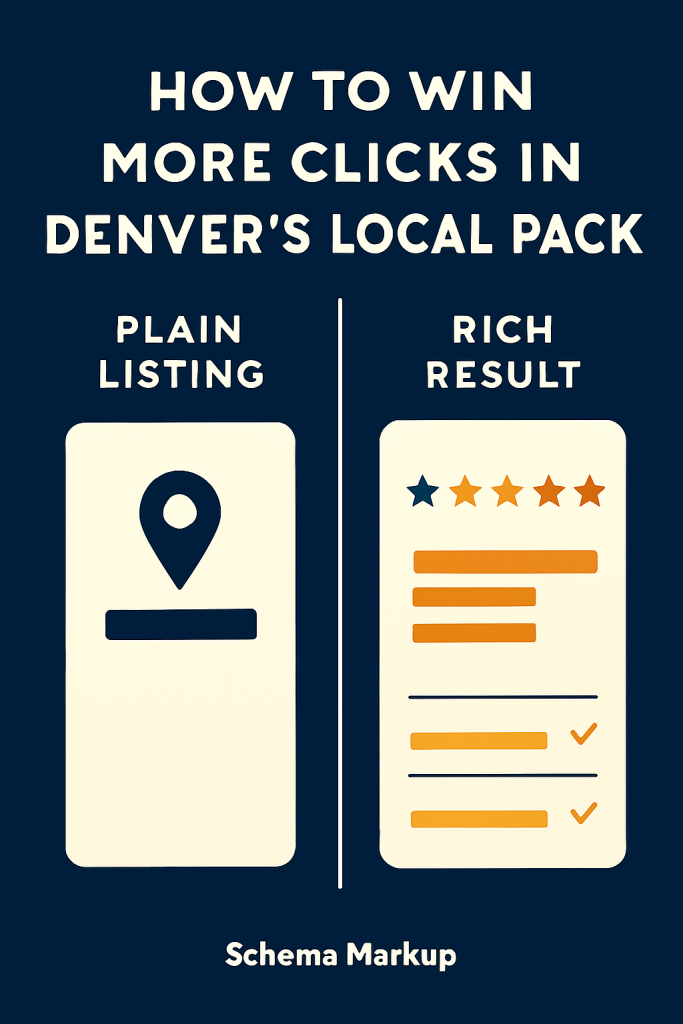How to Use Schema Markup to Win More Clicks in Denver’s Local Pack
If you’re a service business in Denver, showing up in the local pack is only half the battle. The real win is getting clicked. And that’s where schema markup comes in.
Schema isn’t just a technical SEO detail—it’s a visibility tool. It helps Google understand your content, display rich results, and give your listing more visual weight than your competitors. Whether you’re a dentist, electrician, or contractor, schema can turn a plain listing into a click magnet.
Let’s break down how to use schema markup to win more clicks in Denver’s local pack, with real-world examples of what changes on the SERP—and why it matters.
Why Schema Markup Actually Matters
Most Denver service businesses show up in search—but their listings look flat. No stars. No service details. No reason to click.
Schema markup fixes that. It’s a way to tell Google exactly what’s on your site, using structured data that lives in your code. When it’s done right, your listing gets upgraded with rich results: reviews, FAQs, service tags, and more.
This isn’t just a technical SEO checkbox. It’s how you get noticed in a crowded local pack. If your competitor’s listing has stars, pricing, and service highlights—and yours doesn’t—you’re losing clicks.
We’ve seen it firsthand. A plain listing gets ignored. A rich result gets booked.
For local businesses, the most valuable types of schema are:
Service schema
Review markup
FAQ schema
Each one plays a different role in how your business shows up—and how often it gets clicked.

Service Schema: Show What You Actually Do
Most service businesses in Denver have generic pages: “We offer plumbing, electrical, HVAC, and more.” But Google doesn’t guess. If your site doesn’t clearly define your services, you won’t rank for them—and you won’t show up with rich results.
Service schema lets you spell it out. You can tag each service with its name, description, area served, and pricing structure. That helps Google match your business to specific searches like “EV charger installation near Cherry Creek” or “Denver cosmetic dentist for veneers.”
Before schema:
A plain listing with your business name, address, and phone number. No service details. No visual enhancements.
After schema:
Your listing includes “EV Charger Installation,” “Panel Upgrades,” or “Teeth Whitening” right under your name. It looks like a mini menu—and it gets clicked.
We implement service schema as part of our on-page SEO process. It’s not just code—it’s conversion.
Review Markup: Build Trust Before the Click
Reviews matter. But if they’re buried on your site—or only visible on third-party platforms—you’re missing out.
Review markup pulls your ratings into the search results. That means stars under your listing, snippets of customer feedback, and trust signals before someone even lands on your site.
Before markup:
Your listing looks like everyone else’s. No stars. No proof you’re legit.
After markup:
Your listing shows 4.9 stars from 87 reviews. One line says “Fast, professional, and affordable.” That’s the difference between a click and a scroll.
We integrate review markup during technical SEO cleanup. It’s not just about ranking—it’s about reputation.
And yes, Google has rules. You can’t fake reviews or mark up testimonials that aren’t visible on the page. We follow best practices to make sure your schema is valid, visible, and working.
FAQ Schema: Answer Questions Before They’re Asked
FAQ schema is one of the easiest ways to add visual depth to your listing. It pulls common questions and answers into the SERP—right under your page title.
This works especially well for service businesses with high-intent searches. Think “How much does a panel upgrade cost in Denver?” or “Can I get teeth whitening during a regular cleaning?”
Before schema:
Your page shows up—but it’s just a title and meta description. No extra info.
After schema:
Your listing includes two or three FAQs with dropdowns. It looks like a mini guide—and it gets clicked.
We build FAQ schema into our SEO content writing process. Every service page includes real questions from real customers—written to convert, not just rank.
Real-World Example: Denver Electrician
One of our electrician clients had a solid site, decent rankings, and good reviews—but their click-through rate was flat. They were showing up in the local pack, but not getting the calls.
We added service schema to highlight EV charger installs, panel upgrades, and emergency repairs. We marked up their reviews to show 4.8 stars from verified customers. And we added FAQ schema to answer common questions about pricing, scheduling, and service areas.
Within weeks, their listing looked completely different. It had stars, service tags, and expandable FAQs. Their click-through rate jumped by 37%. And their call volume followed.
That’s the power of schema. It doesn’t just help Google—it helps people choose you.
How to Implement Schema Without Breaking Your Site
Schema is code. But it doesn’t have to be complicated. We use JSON-LD format, which is clean, lightweight, and recommended by Google. It sits in the header of your page and doesn’t affect how the site looks—just how it’s understood.
We test every schema implementation with Google’s Rich Results tool. We make sure it’s valid, visible, and eligible for enhancements. And we monitor how it performs over time.
If you’re using WordPress, some plugins offer schema features—but most are generic. We customize schema to match your services, your location, and your conversion goals.
Because boilerplate markup doesn’t win clicks. Precision does.
What to Do Next
If your Denver business is showing up but not getting clicked, schema might be the missing piece. It’s not just a technical detail—it’s a visibility upgrade.
We specialize in helping service businesses use schema to stand out, build trust, and get more calls. Whether you’re starting from scratch or trying to fix what’s not working, we’ll build a plan that fits your market and your goals.
Request a free local SEO audit and let’s make sure your listing shows up—and gets clicked.
